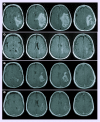Antiangiogenic therapies for glioblastoma
- PMID: 25363007
- PMCID: PMC6113896
- DOI: 10.2217/cns.14.31
Antiangiogenic therapies for glioblastoma
Abstract
Glioblastoma is the most prevalent malignant primary brain tumor in adults and to date effective durable treatments are lacking. Preclinical studies underscore the importance of neovascularization for tumor survival, making angiogenesis an important treatment target. Early clinical experience in recurrent glioblastoma suggested that antiangiogenic agents may provide clinical benefit by prolonging progression-free survival, improving quality of life and decreasing peritumoral edema. Two recent Phase III randomized trials of antiangiogenic therapy at initial diagnosis suggested improvement in progression-free survival, but failed to show an overall survival benefit. Ongoing preclinical research focuses on mechanisms of resistance and potential predictive biomarkers. Identification of targets to resistance pathways and of predictive biomarkers will hopefully improve efficacy of antiangiogenic therapies.
Keywords: VEGF; antiangiogenesis; bevacizumab; glioblastoma; proangiogenic factors; resistance mechanisms; small-molecule inhibitor; vascular endothelial growth factor.
Conflict of interest statement
Figures

Similar articles
-
The future of antiangiogenic treatment in glioblastoma.Curr Opin Neurol. 2014 Dec;27(6):675-82. doi: 10.1097/WCO.0000000000000142. Curr Opin Neurol. 2014. PMID: 25313693 Review.
-
Lessons from anti-vascular endothelial growth factor and anti-vascular endothelial growth factor receptor trials in patients with glioblastoma.J Clin Oncol. 2015 Apr 1;33(10):1197-213. doi: 10.1200/JCO.2014.55.9575. Epub 2015 Feb 23. J Clin Oncol. 2015. PMID: 25713439 Free PMC article.
-
Current status of antiangiogenic therapies for glioblastomas.Expert Opin Investig Drugs. 2014 Feb;23(2):199-210. doi: 10.1517/13543784.2014.856880. Epub 2013 Dec 10. Expert Opin Investig Drugs. 2014. PMID: 24320142 Review.
-
Is there a world beyond bevacizumab in targeting angiogenesis in glioblastoma?Expert Opin Investig Drugs. 2012 May;21(5):605-17. doi: 10.1517/13543784.2012.670219. Epub 2012 Mar 13. Expert Opin Investig Drugs. 2012. PMID: 22413865 Review.
-
New Directions in Anti-Angiogenic Therapy for Glioblastoma.Neurotherapeutics. 2017 Apr;14(2):321-332. doi: 10.1007/s13311-016-0510-y. Neurotherapeutics. 2017. PMID: 28083806 Free PMC article. Review.
Cited by
-
Transmembrane Protein TMEM230, a Target of Glioblastoma Therapy.Front Cell Neurosci. 2021 Nov 17;15:703431. doi: 10.3389/fncel.2021.703431. eCollection 2021. Front Cell Neurosci. 2021. PMID: 34867197 Free PMC article.
-
Hemorrhagic and ischemic risks of anti-VEGF therapies in glioblastoma.Cancer Gene Ther. 2025 Jul;32(7):762-777. doi: 10.1038/s41417-025-00914-8. Epub 2025 May 21. Cancer Gene Ther. 2025. PMID: 40394233 Review.
-
Vascular toxicities with VEGF inhibitor therapies-focus on hypertension and arterial thrombotic events.J Am Soc Hypertens. 2018 Jun;12(6):409-425. doi: 10.1016/j.jash.2018.03.008. Epub 2018 Mar 21. J Am Soc Hypertens. 2018. PMID: 29703600 Free PMC article. Review.
-
Computational Fractal-Based Analysis of MR Susceptibility-Weighted Imaging (SWI) in Neuro-Oncology and Neurotraumatology.Adv Neurobiol. 2024;36:445-468. doi: 10.1007/978-3-031-47606-8_23. Adv Neurobiol. 2024. PMID: 38468047
-
IDO1 Inhibitor RY103 Suppresses Trp-GCN2-Mediated Angiogenesis and Counters Immunosuppression in Glioblastoma.Pharmaceutics. 2024 Jun 28;16(7):870. doi: 10.3390/pharmaceutics16070870. Pharmaceutics. 2024. PMID: 39065567 Free PMC article.
References
-
- Stupp R, Mason WP, Van Den Bent MJ, et al. Radiotherapy plus concomitant and adjuvant temozolomide for glioblastoma. N. Engl. J. Med. 2005;352(10):987–996. - PubMed
-
- Plate KH, Breier G, Weich HA, Risau W. Vascular endothelial growth factor is a potential tumour angiogenesis factor in human gliomas in vivo. Nature. 1992;359(6398):845–848. - PubMed
-
- Kim KJ, Li B, Winer J, et al. Inhibition of vascular endothelial growth factor-induced angiogenesis suppresses tumour growth in vivo. Nature. 1993;362(6423):841–844. - PubMed
-
- Jensen RL, Ragel BT, Whang K, Gillespie D. Inhibition of hypoxia inducible factor-1alpha (HIF-1alpha) decreases vascular endothelial growth factor (VEGF) secretion and tumor growth in malignant gliomas. J. Neurooncol. 2006;78(3):233–247. - PubMed
-
- Folkman J. Angiogenesis: an organizing principle for drug discovery? Nat. Rev. Drug Discov. 2007;6(4):273–286. - PubMed
Publication types
MeSH terms
Substances
LinkOut - more resources
Full Text Sources
Other Literature Sources
Medical
Molecular Biology Databases
